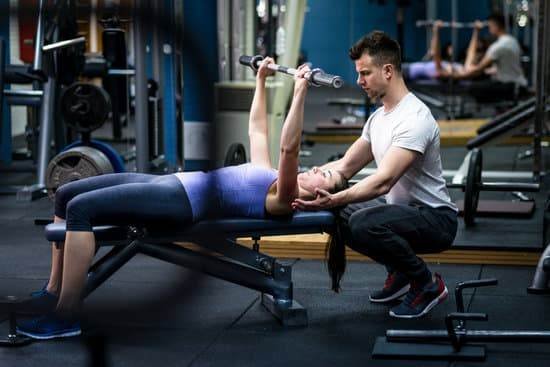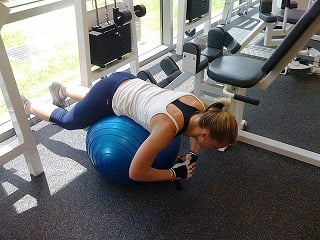The field of fitness training has experienced a surge in popularity, with more individuals seeking the guidance and expertise of qualified fitness trainers to help them achieve their health and wellness goals. In this article, we will explore how to become a fitness trainer, starting from assessing your own personal fitness level to gaining practical experience and building a strong client base.
As the importance of maintaining an active and healthy lifestyle becomes increasingly recognized, the demand for knowledgeable and skilled fitness trainers continues to grow. A qualified fitness trainer not only possesses the expertise to guide individuals through effective workout routines but also serves as a source of motivation and support in their journey towards optimal well-being.
Before embarking on a career as a fitness trainer, it is crucial to understand the role they play in helping individuals reach their desired level of fitness. Fitness trainers are responsible for designing personalized exercise programs, providing guidance on nutrition and lifestyle choices, and monitoring clients’ progress. Their impact goes beyond physical transformation – they have the power to positively influence clients’ overall confidence, self-esteem, and motivation.
In order to become an effective fitness trainer, it is essential to evaluate your current level of personal fitness. Understanding your physical capabilities allows you to provide appropriate guidance and tailor workouts that suit individual needs. Additionally, assessing your own strengths and weaknesses helps you identify areas for improvement as you pursue a career in this field.
The Role of a Fitness Trainer
Explaining the Responsibilities and Duties of a Fitness Trainer
A fitness trainer plays a crucial role in helping individuals achieve their fitness goals. They are responsible for designing and implementing personalized exercise programs, providing guidance on nutrition and lifestyle choices, and offering motivation and support throughout the fitness journey. Fitness trainers assess clients’ needs, create workout plans tailored to their abilities and goals, and monitor progress to ensure effective results.
In addition to developing exercise regimens, fitness trainers also educate clients about proper form and technique to prevent injuries during workouts. They provide demonstrations, correct any mistakes in posture or movement, and offer modifications for exercises based on individual’s physical limitations or existing health conditions. Furthermore, trainers constantly track clients’ progress by monitoring body measurements, strength gains, endurance levels, and overall fitness improvements.
The Positive Impact of a Fitness Trainer on Individuals’ Lives
The role of a fitness trainer extends beyond physical training. They become mentors, motivators, and sources of inspiration for their clients. By creating a supportive environment, trainers empower individuals to overcome challenges and barriers that may have hindered their progress in the past. They provide accountability by scheduling regular sessions, setting achievable goals, and tracking performance.
Moreover, a fitness trainer can have a profound impact on an individual’s mental well-being. Regular exercise has been linked to reduced stress levels, improved mood, increased self-confidence, and better sleep patterns. Trainers not only guide clients through workouts but also offer emotional support during difficult times. The encouragement provided by a trainer can boost self-esteem as clients witness their physical capabilities improve over time.
By having someone who believes in them every step of the way, individuals often find themselves gaining more than just physical strength – they develop greater self-belief and resilience that transcends into other areas of their lives. The positive impact made by a fitness trainer can extend far beyond reaching specific health or fitness goals, creating lasting changes that improve overall quality of life.
Assessing Personal Fitness Level
Before pursuing a career as a fitness trainer, it is crucial to assess and understand your own personal fitness level. Evaluating your fitness level not only helps you gauge your physical capabilities but also provides a foundation for setting realistic goals and developing effective training programs for yourself and future clients.
One of the first steps in assessing your personal fitness level is determining your body composition. This involves measuring factors such as body fat percentage, muscle mass, and overall weight. There are various methods to accurately measure body composition, including skinfold calipers, bioelectrical impedance analysis (BIA), and dual-energy x-ray absorptiometry (DEXA).
In addition to body composition, determining cardiovascular endurance is another important aspect of assessing personal fitness. This can be done through timed runs or walks to measure how efficiently your heart and lungs can supply oxygen to the muscles during physical activity. Other tests that assess cardiovascular endurance include cycling or swimming for a certain duration or distance.
Once you have determined your body composition and cardiovascular endurance, evaluating muscular strength and flexibility is essential. Strength tests can involve measuring how much weight you can lift for specific exercises or performing exercises such as push-ups, pull-ups, or squats for a certain number of repetitions. Flexibility assessments typically include tests like the sit-and-reach test or shoulder flexibility measurements.
Taking the time to assess your personal fitness level allows you to gain insight into any areas that may need improvement. It also gives you a baseline from which to set achievable goals and create personalized training plans tailored to individual needs.
| Component | Assessment Methods |
|---|---|
| Body Composition | Skinfold calipers, BIA, DEXA |
| Cardiovascular Endurance | Timed runs/walks, cycling, swimming |
| Muscular Strength | Lifting weights, push-ups, pull-ups, squats |
| Flexibility | Sit-and-reach test, shoulder flexibility measurements |
Education and Certification
When it comes to becoming a fitness trainer, education and certification play a crucial role in establishing credibility and expertise in the field. While there are no strict educational requirements to become a fitness trainer, completing relevant coursework or obtaining a degree in exercise science, kinesiology, or a related field can provide you with a solid foundation of knowledge.
One of the most important aspects of education as a fitness trainer is gaining an understanding of anatomy, physiology, and exercise science principles. This knowledge will not only enhance your ability to design effective workout programs but also enable you to educate clients about proper form, technique, and injury prevention.
In addition to formal education, earning a certification is highly recommended for aspiring fitness trainers. Certifications demonstrate that you have met certain standards of competence and professionalism. There are various respected organizations that offer certifications such as the National Academy of Sports Medicine (NASM), American Council on Exercise (ACE), and International Sports Sciences Association (ISSA).
Here is a list of some well-known fitness training certifications:
- NASM Certified Personal Trainer.
- ACE Certified Personal Trainer.
- ISSA Certified Fitness Trainer.
- ACSM Certified Personal Trainer.
While each certification has its own specific requirements and exams, they typically cover topics such as exercise physiology, anatomy, program design, nutrition basics, and client assessment. By obtaining a certification from one of these organizations or others with reputable credentials, you are not only increasing your marketability but also ensuring that you are equipped with the necessary skills and knowledge to provide professional fitness training services.
Remember that continuing education is also essential for personal growth as a fitness trainer. As new research emerges and fitness trends change over time, staying updated with the latest information will help you deliver the best results for your clients. Consider attending workshops or conferences related to your niche area of specialization or seeking advanced certifications to further expand your knowledge base.
By prioritizing education and certification throughout your fitness training journey, you will not only gain valuable skills and knowledge but also establish yourself as a qualified professional in the industry. Taking the time to invest in your education will pay off in the long run and help you make a positive impact on the lives of your clients.
Choosing the Right Fitness Training Program
When pursuing a career as a fitness trainer, selecting the right training program is crucial. It can greatly impact the quality of education received and the credibility that comes with it. With numerous options available, it is important to consider certain factors before making a decision.
- Curriculum: One of the first things to evaluate when choosing a fitness training program is its curriculum. Look for programs that offer comprehensive courses covering various aspects of fitness training, including exercise physiology, anatomy, nutrition, and program design. A well-rounded curriculum will provide you with the knowledge needed to effectively work with clients and help them reach their fitness goals.
- Hands-on Experience: Practical experience is essential in becoming a successful fitness trainer. Look for programs that provide hands-on experience through internships or practicum opportunities. These experiences allow you to apply the knowledge gained in real-world scenarios and develop crucial skills in working with diverse populations.
- Accreditation: Accreditation ensures that a training program meets certain standards of quality and educational rigor. When considering different programs, look for those that are accredited by reputable organizations such as the National Commission for Certifying Agencies (NCCA) or Accrediting Council for Continuing Education and Training (ACCET). This accreditation provides assurance that the program meets industry standards and will be recognized by employers.
In addition to these factors, it is beneficial to research reviews and testimonials from past students of the program to gain insight into their experiences and outcomes. Talking to professionals already working in the field can also provide valuable guidance on which programs are highly regarded within the industry.
By carefully considering these factors and doing thorough research, aspiring fitness trainers can choose a reputable training program that will equip them with the necessary knowledge and skills to excel in their careers.
| Factor | Considerations |
|---|---|
| Curriculum | Comprehensive coverage of exercise physiology, anatomy, nutrition, and program design. |
| Hands-on Experience | Opportunities for internships or practicums to apply knowledge in real-world scenarios. |
| Accreditation | Program accredited by reputable organizations such as NCCA or ACCET. |
Gaining Practical Experience
Gaining practical experience is a crucial step in becoming a successful fitness trainer. While education and certification provide the necessary foundation, practical experience allows trainers to apply their knowledge and skills in real-life situations. Here are some effective strategies to gain practical experience in the fitness industry:
- Internship opportunities: Many fitness training programs offer internships that allow aspiring trainers to work under the guidance of experienced professionals. These internships provide valuable hands-on experience in designing workout programs, conducting assessments, and working with clients directly.
- Shadowing experienced trainers: Another way to gain practical experience is by shadowing experienced trainers. This involves observing their training sessions, asking questions, and learning from their expertise. By shadowing different trainers with varied specializations, you can gain a broader understanding of different training techniques and approaches.
- Working at fitness centers or gyms: Working at fitness centers or gyms is an excellent way to gain practical experience while also earning an income. As a fitness trainer at a gym or center, you will have the opportunity to work with a diverse range of clients with varying goals and fitness levels. This hands-on experience will help you develop your coaching abilities and improve your ability to tailor workouts for different individuals.
- Volunteering for community events: Volunteering for community fitness events such as charity runs or sports tournaments can also provide valuable practical experience. These events often require trainers to assist participants with warm-ups, cool-downs, and injury prevention techniques. Volunteering not only allows you to practice your skills but also helps you build connections within the local fitness community.
Gaining practical experience is not only important for honing your skills as a fitness trainer but also for establishing credibility within the industry. Potential clients are more likely to trust trainers who have real-world experience working with individuals like themselves. By following these strategies and actively seeking opportunities for practical experience, you will be better equipped to launch a successful career as a fitness trainer.
Developing Specializations
Once you have established a solid foundation as a fitness trainer, it can be beneficial to consider developing specializations in specific areas of the fitness industry. Specializing allows you to enhance your expertise, expand your knowledge base, and ultimately attract a more targeted client base.
One area to consider specializing in is strength training. Strength training has become increasingly popular among individuals looking to improve their overall strength, build muscle, and enhance their athletic performance. By becoming a specialist in strength training, you can offer personalized workout plans tailored to clients’ specific goals and help them achieve their desired results.
Another specialization option is sports conditioning. Many athletes are constantly seeking ways to improve their performance and prevent injuries. By focusing on sports conditioning, you can work closely with athletes of all levels and help them optimize their athletic abilities through targeted exercise programs, injury prevention strategies, and sport-specific training techniques.
Working with special populations is another rewarding specialization that can broaden your career opportunities as a fitness trainer. This can involve working with individuals who have specific health concerns or limitations such as older adults, pregnant women, or those with chronic conditions like diabetes or obesity. Developing expertise in this area will enable you to provide specialized services that cater to the unique needs of these populations and help them improve their overall health and well-being.
By developing specializations in areas like strength training, sports conditioning, or working with special populations, you not only enhance your own professional growth but also position yourself as an expert within the industry. Specializing gives you a competitive edge by allowing you to target specific markets that may be underserved by general fitness trainers.
It also opens up opportunities for collaboration with other professionals such as physical therapists or nutritionists who may refer clients to you based on your specialized knowledge.
Remember that developing specializations takes time and continuous learning. Stay updated with the latest research and trends in your chosen area of specialization through workshops, conferences, and advanced certifications. By investing in your education and professional growth, you can establish yourself as a trusted authority in your niche and continue to evolve as a fitness trainer.
Building a Strong Clientele
Building a strong clientele is an essential aspect of being a successful fitness trainer. In this section, we will discuss strategies on how to attract and retain clients, as well as the significance of networking, referrals, and positive client testimonials.
Networking
Networking plays a crucial role in building a clientele base for fitness trainers. Attending industry events, such as fitness expos or trade shows, provides opportunities to meet potential clients. Engaging in conversations and establishing connections with other professionals in the field can lead to referrals and recommendations. Additionally, joining professional organizations or online communities related to fitness training can expand your network and create potential business contacts.
Referrals
Word-of-mouth referrals are extremely powerful in the fitness industry. Satisfied clients who have achieved their fitness goals are likely to recommend your services to their friends, family members, or colleagues. To encourage referrals, it’s important to focus on providing exceptional service that surpasses client expectations. Offering incentives for referrals, such as discounted sessions or loyalty rewards, can also motivate clients to spread the word about your services.
Positive Client Testimonials
Positive testimonials from satisfied clients can be highly influential in attracting new clients. It’s essential to request feedback from your current clients and ask if they would be willing to share their experience through written testimonials or video testimonials that can be featured on your website or social media platforms. These testimonials serve as social proof of your expertise and credibility as a fitness trainer.
Remember that building a strong clientele takes time and effort. Providing personalized training programs tailored to each client’s goals and needs is crucial in achieving long-term success both for yourself and your clients. By dedicating yourself to helping individuals achieve their fitness goals, utilizing effective networking strategies, seeking referrals from satisfied clients, and presenting positive testimonials, you’ll be on track towards establishing a thriving clientele base as a fitness trainer.
Continuing Education and Professional Growth
In the fitness industry, it is crucial for fitness trainers to stay updated with the latest trends, research, and techniques. Continuing education and professional growth are essential for maintaining a competitive edge in this field. By continually learning and expanding their knowledge, fitness trainers can provide the best possible service to their clients.
One way to pursue continuing education is by attending workshops and conferences. These events offer opportunities to learn from industry experts, gain new insights, and network with other professionals. Workshops often focus on specific topics such as nutrition, injury prevention, or specialized training techniques. Attending conferences allows fitness trainers to stay informed about the latest industry advancements and connect with like-minded individuals.
Another avenue for professional development is seeking advanced certifications. These certifications provide an opportunity for fitness trainers to specialize in specific areas of interest or work with specific populations. Examples of advanced certifications include strength and conditioning specialist certification, corrective exercise specialist certification, or nutrition coach certification. By obtaining these additional qualifications, fitness trainers can expand their expertise and attract clients who require specialized guidance.
In addition to attending workshops and pursuing advanced certifications, staying up-to-date with research is critical for professional growth. The fitness industry is constantly evolving, and new studies emerge regularly that challenge previous beliefs or introduce innovative training methods.
Fitness trainers should make it a habit to read scientific articles, follow reputable sources in the field, and keep abreast of current research findings. This commitment to staying informed ensures that they can provide evidence-based training strategies that yield optimal results for their clients.
Continuing education in the fitness industry not only benefits individual trainers but also contributes to raising standards across the profession as a whole. By prioritizing ongoing learning and professional growth, fitness trainers demonstrate their commitment to providing high-quality services that help individuals achieve their fitness goals effectively and safely.
Conclusion
In conclusion, becoming a fitness trainer is an exciting and rewarding career choice that is growing in popularity. The role of a fitness trainer goes beyond simply guiding individuals through workouts; they have the power to transform lives by helping clients achieve their fitness goals and improve their overall well-being. However, before embarking on this career path, it is essential to assess your own personal fitness level and understand the physical demands of the job.
Education and certification are crucial aspects of becoming a successful fitness trainer. Pursuing a degree or certification program not only provides you with the necessary knowledge and skills but also enhances your credibility in the industry. When choosing a fitness training program, it is important to do thorough research, considering factors such as curriculum, hands-on experience opportunities, and accreditation.
Gaining practical experience is equally important for aspiring fitness trainers. Internships, shadowing experienced trainers, or working at fitness centers or gyms can provide invaluable insights into the field and help you develop your expertise further. Additionally, specializing in specific areas of interest, such as strength training or sports conditioning, can open up more career opportunities and attract a wider client base.
As you embark on your journey as a fitness trainer, building a strong clientele is key to sustainable success. Networking, seeking referrals from satisfied clients, and maintaining positive client testimonials are effective strategies to attract new clients and retain their loyalty. Furthermore, continuing education and professional growth are critical for staying updated with the latest trends in the industry. Attending workshops, conferences, and obtaining advanced certifications will ensure that you remain at the forefront of the field.
In summary, becoming a fitness trainer requires dedication, education, practical experience, specialization in specific areas of interest, building a strong clientele base through networking and referrals ,as well as continuing education for professional growth. By following these steps outlined in this article and taking the first steps towards pursuing this fulfilling career path, you will be on your way to making a meaningful impact in the lives of others through fitness training.
Frequently Asked Questions
What qualifications do you need to be a fitness instructor?
To be a fitness instructor, there are certain qualifications and certifications that are typically required. These may vary depending on the specific type of fitness training you want to specialize in, such as personal training, group fitness instruction, or specialized programs like yoga or Pilates. Generally, most fitness instructors need to obtain a certification from a reputable organization recognized by the industry.
These certifications often involve completing specific courses, passing exams, and meeting certain prerequisites such as CPR certification. In addition to certifications, having good communication skills and the ability to motivate and inspire others is essential for a successful career as a fitness instructor.
How do I start a fitness trainer?
Starting a career as a fitness trainer involves taking several important steps. Firstly, it’s essential to acquire the necessary education and certifications mentioned earlier. Research various reputable organizations that offer certifications in your preferred area of expertise and select one that suits your goals.
Once you have obtained the relevant certification, gaining practical experience is crucial for establishing yourself as a competent trainer. This can be done through internships or part-time work at local gyms or fitness centers while continuing to enhance your skills and knowledge through ongoing professional development opportunities. Finally, consider establishing your own brand by creating an online presence through social media platforms or building relationships with potential clients in your local community.
Can you make good money as a fitness trainer?
The earning potential for fitness trainers can vary widely based on factors such as location, experience level, specialization areas, clientele base, and entrepreneurial ventures pursued alongside training services. As with any profession, individuals who demonstrate exceptional skills and dedication tend to have more opportunities for higher pay rates. Many trainers start their careers working for gyms or fitness studios where earnings may be entry-level but can increase over time as they gain experience and establish themselves within the field.
Additionally, private trainers who build their client base can potentially earn significantly more per session than those employed by larger establishments; however, this may also require additional marketing efforts and business management skills on their part to maintain a steady income stream. Ultimately, the earning potential as a fitness trainer varies and depends on various factors, but with the right skill set and determination, it is possible to make good money in this profession.

Passionate about providing useful information to anyone with an interest in the field of Personal Training, I strive to pass on to our readers quality information and to answer any questions about Personal Trainers, the work they do and how to become one.





